What is electrical resistance?
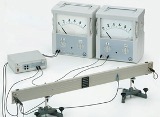 The electric current I in any substance is created by the movement of charged particles in a certain direction due to the application of external energy (potential difference U). Each substance has individual properties that affect the flow of current in it in different ways. These properties are evaluated by the electrical resistance R.
The electric current I in any substance is created by the movement of charged particles in a certain direction due to the application of external energy (potential difference U). Each substance has individual properties that affect the flow of current in it in different ways. These properties are evaluated by the electrical resistance R.
Georg Ohm empirically determined the factors affecting the magnitude of the electrical resistance of a given substance formula of its dependence of voltage and current which is named after him. The SI unit of resistance is named after him. 1 ohm is the resistance value measured at 0°C for a homogeneous column of mercury 106.3 cm long with a cross-sectional area of 1 mm2.
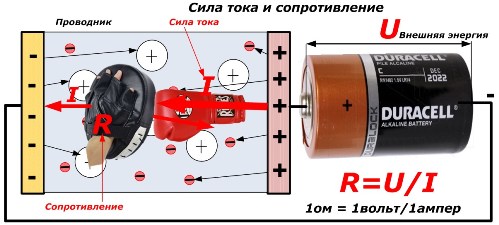
Definition
In order to evaluate and apply in practice materials for the production of electrical devices, the term «Conductor resistance» was introduced... The added adjective "specific" indicates the coefficient of use of the volume reference value accepted for the substance in question. This makes it possible to evaluate the electrical parameters of different materials.
In this case, it is taken into account that the resistance of the wire increases with an increase in its length and a decrease in its cross-section. The SI system uses the volume of a homogeneous wire 1 meter long and 1 m2 in cross-section... In technical calculations, an outdated but convenient unit of volume outside the system is used, consisting of a length of 1 meter and an area of 1 mm.2... The formula for resistance ρ is shown in the figure.

To determine the electrical properties of substances, another characteristic is introduced — specific conductivity b. It is inversely proportional to the resistance value, determines the ability of the material to conduct electric current: b = 1 / p.
How resistance depends on temperature
The conductivity of a material is affected by its temperature. Different groups of substances do not behave the same when heated or cooled. This property is taken into account for electric wires operating outdoors in hot and cold weather.
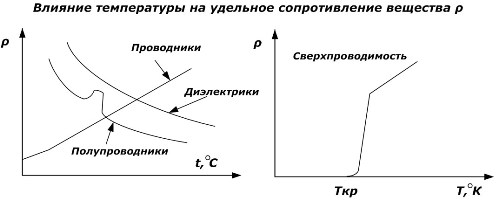
The material and specific resistance of the conductor are selected taking into account the conditions of its operation.
The increase in the resistance of wires to the passage of current during heating is explained by the fact that as the temperature of the metal in it increases, the intensity of movement of atoms and carriers of electric charges in all directions increases, which creates unnecessary obstacles to the movement of charged particles in one direction and reduces the value of their flux.
If the temperature of the metal decreases, then the conditions for the passage of current improve.When cooled to a critical temperature, the phenomenon of superconductivity appears in many metals, when their electrical resistance is practically zero. This property is widely used in high power electromagnets.
The effect of temperature on the conductivity of metals is used by the electrical industry in the manufacture of ordinary incandescent lamps. Theirs nichrome thread when the current is passed, it is heated to such a state that it emits a luminous flux. Under normal conditions, the resistance of nichrome is about 1.05 ÷ 1.4 (ohm ∙ mm2) / m.
When the bulb is switched on under voltage, a large current passes through the filament, which very quickly heats up the metal. At the same time, the resistance of the electrical circuit increases, limiting the starting current to the nominal value necessary to obtain lighting. In this way, a simple regulation of the current strength is carried out by means of a nichrome spiral, there is no need to use complex ballasts used in LED and fluorescent sources.
How is the resistance of materials used in engineering
Non-ferrous precious metals have the best electrical conductivity properties. Therefore, critical contacts in electrical devices are made of silver. But this increases the final price of the entire product. The most acceptable option is to use cheaper metals. For example, the resistance of copper equal to 0.0175 (ohm ∙ mm2) / m is quite suitable for such purposes.
Noble metals - gold, silver, platinum, palladium, iridium, rhodium, ruthenium and osmium, named mainly for their high chemical resistance and beautiful appearance in jewelry.Also, gold, silver and platinum have high plasticity, and platinum group metals are refractory and, like gold, it is chemically inert. These advantages of precious metals combine.
Copper alloys with good conductivity are used to make shunts that limit the flow of large currents through the measuring head of powerful ammeters.
Resistance of aluminum 0.026 ÷ 0.029 (ohm ∙ mm2) / m is slightly higher than that of copper, but the production and price of this metal is lower. It is also lighter. This explains its wide use in electricity for the production of external wires and cable cores.
Resistance of iron 0.13 (ohm ∙ mm2) / m also allows its use to transmit electric current, but this leads to greater power losses. Steel alloys have increased strength. Therefore, steel strands are woven into the aluminum overhead conductors of high-voltage power lines that are designed to withstand breaking loads.
This is especially true when ice forms on wires or strong gusts of wind.
Some alloys, for example constantine and nickeline, have thermally stable resistive characteristics within a certain range. The electrical resistance of Nickeline practically does not change from 0 to 100 degrees Celsius. Therefore, rheostat coils are made of nickel.
In measuring instruments, the property of a strict change in the resistance values of platinum with respect to its temperature is widely used. If an electric current from a stabilized voltage source is passed through a platinum wire and the resistance value is calculated, it will indicate the temperature of the platinum.This allows the scale to be graduated in degrees corresponding to ohm values. This method allows you to measure the temperature with an accuracy of fractions of a degree.
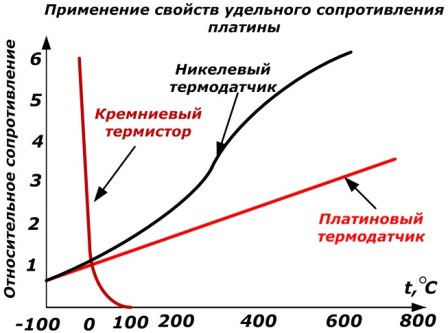
Sometimes, to solve practical problems, you need to know the general or specific resistance of the cable... For this purpose, the cable product directories provide the values of the inductive and active resistance of a single core for each value of the cross section. They are used to calculate the permissible loads, the generated heat, determine the permissible operating conditions and choose effective protection.
The specific conductivity of metals is affected by how they are processed. The use of pressure for plastic deformation disrupts the crystal lattice structure, increases the number of defects, and increases the resistance. To reduce it, recrystallization annealing is used.
Stretching or compressing metals causes elastic deformation in them, from which the amplitudes of the thermal vibrations of the electrons decrease, and the resistance decreases somewhat.
When designing earthing systems, it is necessary to take into account soil resistance… It differs by definition from the above method and is measured in SI units — Ohms. Meter. With its help, the quality of distribution of electric current inside the ground is evaluated.
Dependence of soil resistance on soil moisture and temperature:
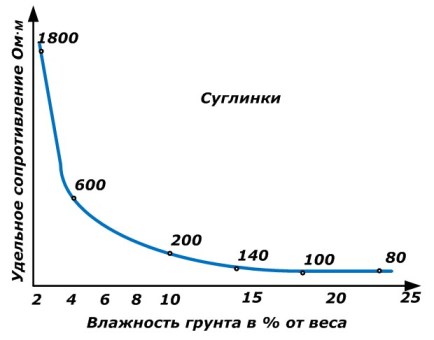
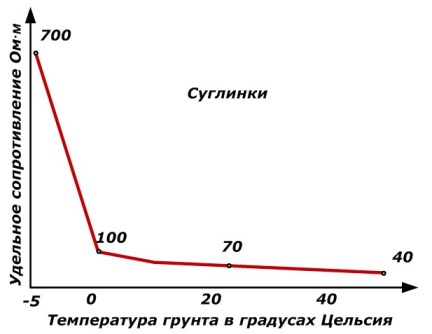
Soil conductivity is affected by many factors, including soil moisture, density, particle size, temperature, concentration of salts, acids, and bases.
